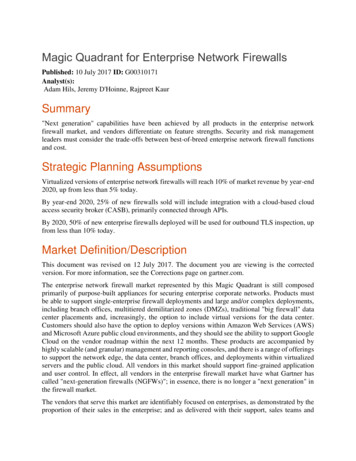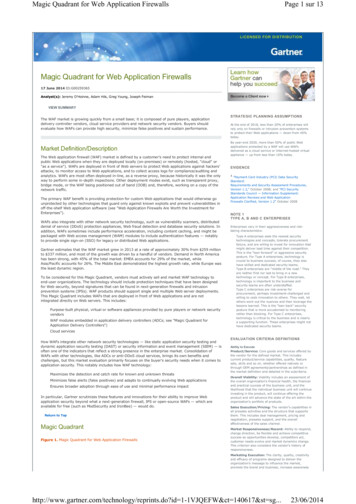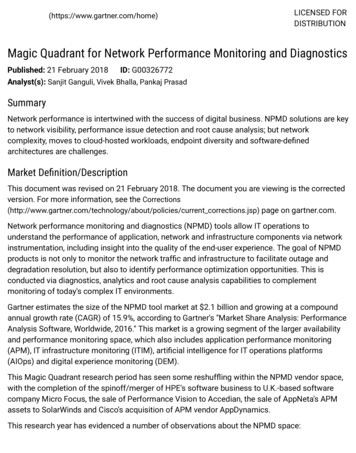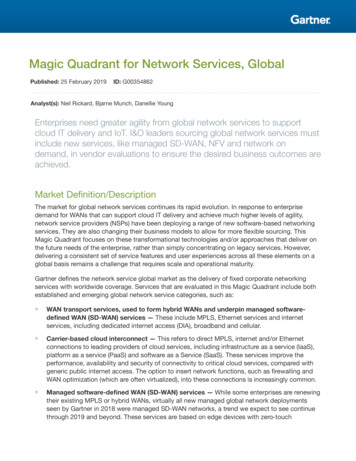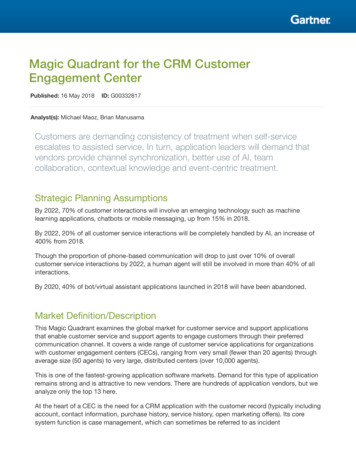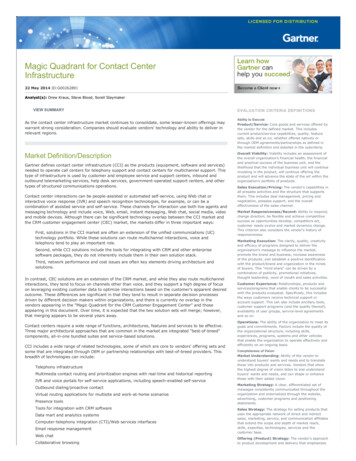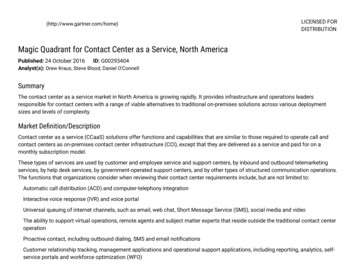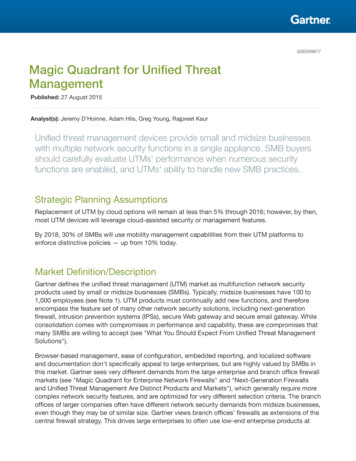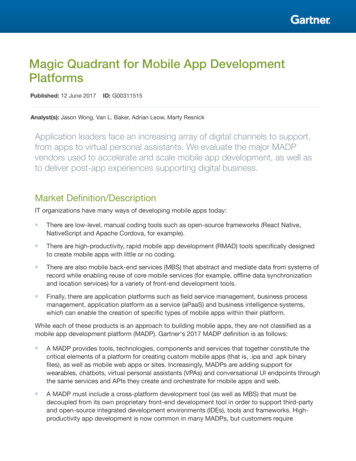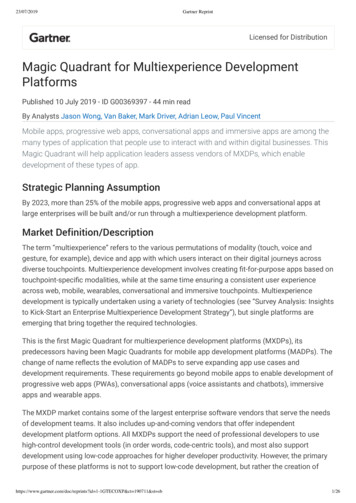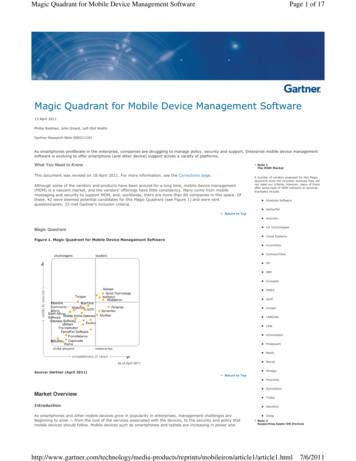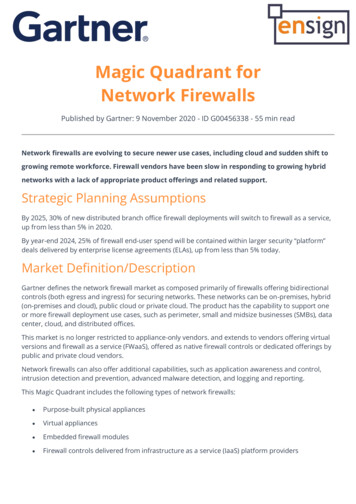
Transcription
Magic Quadrant forNetwork FirewallsPublished by Gartner: 9 November 2020 - ID G00456338 - 55 min readNetwork firewalls are evolving to secure newer use cases, including cloud and sudden shift togrowing remote workforce. Firewall vendors have been slow in responding to growing hybridnetworks with a lack of appropriate product offerings and related support.Strategic Planning AssumptionsBy 2025, 30% of new distributed branch office firewall deployments will switch to firewall as a service,up from less than 5% in 2020.By year-end 2024, 25% of firewall end-user spend will be contained within larger security “platform”deals delivered by enterprise license agreements (ELAs), up from less than 5% today.Market Definition/DescriptionGartner defines the network firewall market as composed primarily of firewalls offering bidirectionalcontrols (both egress and ingress) for securing networks. These networks can be on-premises, hybrid(on-premises and cloud), public cloud or private cloud. The product has the capability to support oneor more firewall deployment use cases, such as perimeter, small and midsize businesses (SMBs), datacenter, cloud, and distributed offices.This market is no longer restricted to appliance-only vendors. and extends to vendors offering virtualversions and firewall as a service (FWaaS), offered as native firewall controls or dedicated offerings bypublic and private cloud vendors.Network firewalls can also offer additional capabilities, such as application awareness and control,intrusion detection and prevention, advanced malware detection, and logging and reporting.This Magic Quadrant includes the following types of network firewalls: Purpose-built physical appliances Virtual appliances Embedded firewall modules Firewall controls delivered from infrastructure as a service (IaaS) platform providers
Dedicated FWaaS (Note: FWaaS is a service directly hosted and sold by the vendor, and is not ahosted firewall service offered by managed security service providers [MSSPs], telcos or anyother partner).Magic QuadrantFigure 1. Magic Quadrant for Network FirewallsSource: Gartner (November 2020)
Vendor Strengths and CautionsBarracudaBarracuda is a Niche Player in this Magic Quadrant. Its firewall product line is called BarracudaCloudGen Firewalls. It has dedicated firewalls for operational technology (OT) and industrial controlsystem (ICS) use cases.This year, Barracuda has introduced Barracuda CloudGen WAN, hosted on Microsoft Azure as asecure SD-WAN offering. Other updates include Firewall Insights, which is Barracuda’s analytics andreporting product offering, and enhancements to cloud IaaS support and Internet of Things (IoT)security.Barracuda focuses on public cloud IaaS and distributed office use cases for its firewalls. Hence,Barracuda CloudGen Firewalls are a good candidate for enterprises looking for mature public IaaSfirewall features and integrated native SD-WAN and VPN features.Strengths Market execution: Barracuda CloudGen Firewalls offer better support features for AmazonWeb Services (AWS) and Microsoft Azure platforms as compared to other firewalls. Thesecapabilities include support for Azure Operations Management Suite (OMS), Azure SecurityCenter (ASC), Azure Sentinel and AWS Amazon CloudWatch, which most other firewall vendorsfail to offer. Product strategy: Barracuda is a good shortlist candidate for the distributed office use case,with integrated SD-WAN and mature VPN capabilities. The vendor regularly introducesenhancements to these features. Recently, it introduced Barracuda CloudGen WAN, hosted onMicrosoft Azure as a secure SD-WAN offering. Pricing: Barracuda CloudGen Firewalls win on pricing versus features. Their subscriptions arebundled and come with inclusive basic technical support. This makes them desirable firewallsfor SMBs, for which pricing is one of the key shortlisting criteria. Product strategy: Apart from dedicated firewalls for OT and ICS use cases, Barracuda alsooffers secure connector products for IoT device connectivity. These connectors providecentralized management and access through Barracuda’s firewall centralized manager —Firewall Control Center — of various IoT devices. CloudGen Firewall products offer support forOT protocols such as S7 , IEC 61850, IEC 60870-5-105, Modbus and DNP3.Cautions Product strategy: Despite Barracuda offering multiple security product lines, it offers nointegration with CloudGen Firewalls, hence not offering operational simplicity to clientsconsolidating toward a single vendor. Sales execution: Gartner doesn’t see ELA deals promoted by the vendor for clients that want toconsolidate toward Barracuda for their multiple security solutions. All the firewall deals aregenerally stand-alone ones, while other vendors that offer multiple security product lines arepromoting ELAs for pricing simplicity for their clients. Market responsiveness: Despite a strong focus on the distributed office use case, the vendordoesn’t offer a cloud-based firewall manager. Barracuda has recently launched a secure SD-
WAN service hosted in Microsoft Azure that includes cloud-based management not currentlyavailable with its CloudGen Firewall. Customer feedback: Gartner clients have reported below-satisfactory technical supportfeedback, contradictory to excellent support feedback that clients used to cite a few years ago.Check Point Software TechnologiesCheck Point Software Technologies is a Leader in this Magic Quadrant. Its firewall product is its mainsecurity product line; its new Quantum Security Gateways series offers firewalls for all use cases,including containers. CloudGuard Connect is the FWaaS offering. Major updates include extendingsupport for cloud security and enhancements around threat prevention, performance and support forIoT security. The vendor has also introduced the centralized cloud-based management portal Smart-1Cloud, Infinity portal and FWaaS.Check Point firewalls are good shortlist candidates for enterprises with a cloud security focus. Thevendor also offers high-performing firewalls for the data center use case. Check Point leads incentralized management capabilities and integration with its endpoint security and mobile securityproduct lines.Strengths Centralized management: Launched in April 2020, and still too recent to have receivedcustomer feedback, Smart-1 Cloud offers feature parity with the Smart-1 on-premises console.Check Point Smart-1’s console appeals especially to managed security service providercustomers and prospects, and distributed enterprises. Policy management: In the hybrid world, where firewall vendors face stronger competitionfrom network security policy management tools for their ability to manage IaaS native controlsand multiple brands, Check Point has a strong base of faithful and satisfied users, praising thepolicy editors and the recent improvement in the R80.x versions. Product strategy: Check Point has accelerated the pace of its cloud security execution,including the integration of CloudGuardDome9, a cloud security posture managementsolution, and CloudGuard Workload serverless security. Threat prevention: Check Point continues to improve its threat detection capabilities.Customers using Threat Extraction, the content disarm and reconstruction feature that is partof the SandBlast bundle, welcome the addition of web downloads as a new layer of protectionfor employees.Cautions Pricing strategy: Although Check Point has succeeded in simplifying its pricing strategy, it lagsbehind its leading competitors in its ability to sell enterprise-level agreements to the largestcustomers. Pricing execution: In the past few years, Gartner analysts continued to receive a sizable amountof reports regarding dissatisfaction with pricing, which have slowly shifted from a focus ontotal cost of ownership (TCO) to more on the high cost of renewing Check Point subscriptions.
Product strategy: Check Point’s strategy to integrate its security virtual machine (VM) withleading SD-WAN providers, rather than add native SD-WAN capabilities, creates a disadvantageagainst its leading competitors when competing for the branch perimeter appliance use case. Support: For providers with a long history and large market share, Gartner expects to receivemore feedback on occasional support issues. While it improved last year, feedback on CheckPoint support, especially outside of North America, continues to be slightly worse than itscompetitors.CiscoCisco is a Challenger in this Magic Quadrant. Cisco offers multiple firewall product lines, the primaryones being Cisco Firepower Threat Defense (FTD) Next-Generation Firewall (NGFW) Series and theMeraki MX series. Cisco also offers FWaaS as a part of its Umbrella secure internet gateway, andindustrial firewalls (the ISA series).Major updates include those around its Firepower Management Center user interface. It alsointroduced SecureX, an integrated management platform that enables visibility and control acrossnetwork, endpoint, cloud and application security.Cisco’s firewall is a good fit for organizations that have experience with Cisco products and want toconsolidate with the same vendor for their security and network products.Strengths Sales strategy: Cisco has a broad product portfolio, and drives customers effectively towardenterprise ELAs, which often include firewall subscriptions and support. It is also an attractiveproposition for clients that want to consolidate with a single vendor. Capability: Customers value the Talos threat research and advanced malware protection (AMP)features available on Firepower. Existing Sourcefire customers also like the IPS integration onFirepower. SecureX is the vendor’s extended detection and response (XDR) platform thatenables visibility and control across Cisco’s network, endpoint, cloud and application securityproducts. Market execution: Cisco Meraki MX provides a simplified security and networking experience tocustomers with distributed small offices that need easy-to-configure, deploy and managenetworking and firewall solutions. Feature: Gartner clients remark on the high quality of Cisco’s VPN, and report that the site-tosite VPN is stable and easy to configure. Many Gartner clients that replace their Cisco AdaptiveSecurity Appliances (ASAs) with a firewall from a different vendor continue to use ASAs for VPNonly.Cautions Product strategy: Cisco offers multiple different security management portals, causing a lot ofoverlap and confusion within the end-user community. The vendor offers Cisco DefenseOrchestrator as a cloud-based centralized manager, Cisco Threat Response (CTR) cloud-basedthreat correlation, Security Analytics and Logging (SAL) cloud-based reporting portal, and thelatest addition, the SecureX extended detection and response platform. Product strategy: Despite having multiple cloud security products, the vendor only offerssupport for AWS and Azure through Cisco NGFWv, and ASAv and ASA for Cisco Meraki vMX.These lack any integration with Cisco’s Tetration, its cloud workload protection platform
(CWPP) offering. As a result, Gartner seldom sees Cisco firewall deployments in public cloudIaaS scenarios. Product strategy: Cisco has different firewall product lines for different deployment use cases.The Meraki and FTD product lines are led by different product teams and have distinctcapabilities and operating systems, leading to operational complexities despite consolidatingtoward a single vendor. Sales execution: Cisco continues to struggle to win firewall evaluations against competitors inpure firewall deals based on technical evaluation alone. “Cisco shops” are the predominantbase of Cisco firewall customers.ForcepointForcepoint is a Visionary in this Magic Quadrant. During the evaluation period, it introduced severalnew firewall models. It also brought a new secure access service edge (SASE) offering to market. Otherupdates include enhancements to AWS and Azure integrations, and a browser-based interface for itsSecurity Management Center (SMC) central management system, for easier administration.Forcepoint firewalls are good shortlist candidates for distributed office use cases where clients arelooking for mature SD-WAN, VPN and centralized management capabilities, and FWaaS. They haveadvanced clustering/high availability, and are also good candidates for midsize enterprises looking formature advanced threat detection features.Strengths Product execution: Forcepoint has strong SD-WAN and VPN capabilities. It plays to thesestrengths by releasing enhancements regularly. It maintains a single endpoint client approachfor all its end-user connectivity, irrespective of the service. Forcepoint offers Wi-Fi on thesmaller modules through additional modules. Offering: Forcepoint firewalls offer some unique capabilities such as built-in user and entitybehavior analytics (UEBA) capability, and integration with AWS Sentinel and Azure SecurityCenter as public IaaS support. There is seamless service-chaining between Forcepoint’sfirewalls and its web security and data loss prevention (DLP) products. Product strategy: This year, Forcepoint introduced its FWaaS. Other than that, it offers acompelling list of cloud security services: Forcepoint Web Security, Forcepoint CASB, ForcepointEmail Security, Forcepoint Dynamic User Protection and Forcepoint Dynamic Data Protection.This shows its strong product strategy toward offering a cloud security service model. Centralized manager: Forcepoint’s centralized firewall manager, SMC, is a very intuitive andeasy-to-use interface, and customer feedback is positive. Administrator roles can be defined,and mapped with select NGFWs, access control lists and domains. There is also anadministrator privilege for approving pending changes with features such as drag-and-drop.Cautions Market execution: Forcepoint focuses too heavily on the distributed office use case andsupport of the emerging SASE trend. While its firewalls have the pote
Magic Quadrant for Network Firewalls Published by Gartner: 9 November 2020 - ID G00456338 - 55 min read Network firewalls are evolving to secure newer use cases, including cloud and sudden shift to growing remote workforce. Firewall vendors have been slow in responding to growing hybrid networks with a lack of appropriate product offerings and related support. Strategic Planning Assumptions By .
